Content Navigation
- Author: Mark Long
- Why Take the SAT?
-
The New 2016 SAT
- Words in Context
- Command of Evidence
- Essay Analyzing a Source
- Math that Matters the Most
- Problems Grounded in Real-World Contexts
- Analysis in Science and in History/Social Studies
- U.S. Founding Documents and the Great Global Conversation
- Everything You Need to Know About the New SAT
- The New SAT. We’re ON IT.
- Everything You Need to Know About the New SAT
- Why You Should Worry About the New SAT Test
- The SAT: How, When, and Where to Take It (and How Much It Costs)
- Preparing to Take the SAT
- Test-Taking Strategies
- What If You Have a Low Score?
Your senior year in high school is a gateway moment in life. Not only is it the summation of your K-12 educational experiences, it is the springboard to your future in higher education. So, while this is an exciting time full of promise, it can also be a source of anxiety as students have a broad range of questions they need to be answered: “How do I get into college?” and “Where will I go to college?” and “How can I get help paying for it?”
One of the key factors to answering those questions is your score on the Scholastic Assessment Test (SAT), which tests your reading, writing, and math abilities. Administered by the not-for-profit College Board, the SAT is one of the primary means of determining student readiness for college, which helps you gain admission to your school of choice as well as what types of scholarship aid your school may be willing to offer you. Also, the SAT is explicitly designed so all students, regardless of background, have the same opportunity to do well.
Why Take the SAT?
The SAT is important to you in 3 fundamental ways:
1
Most colleges require it as part of the admissions application process.
- 8 Things to Know About How Colleges Use Admission Tests (big future) An overview of how colleges do and don’t use scores in the admissions process.
- SAT® Score-Use Practices by Participating Institution (College Board) An exhaustive list of how each US school using the SAT weights different sections and versions of the test.
2
Colleges may award merit scholarships based on SAT scores.
- Guaranteed Scholarships Based on SAT/ACT Scores (PrepScholar) Details how test scores can earn National Merit scholarships as well as which schools automatically award scholarships based on test scores.
- Merit Scholarships for SAT and ACT Scores (Princeton Review) Explains how even if your college of choice doesn’t require the SAT, taking it can still lead to significant merit-based scholarships.
3
Taking the SAT can help mitigate a low high school GPA.
- What do Colleges Think About High SAT Scores and Low Grades? (College Admissions Partners) The way colleges may view someone who is smart by birth but a slacker by inclination.
- How Important is Your SAT Score? (Veritas Prep) Another take on the importance of your SAT scores beyond just gaining admittance to the college of your choice.
Your SAT is also important to colleges and universities as their U.S. News & World Report college rankings are based partially on the average SAT score of their students. These rankings are broken out by types of school in a variety of ways: nationally and regionally as well as in different program areas (engineering, business, and more). This information can help you see how your score fits in with a college’s admissions profile as well as which schools have the best program you’re interested in.
The New 2016 SAT
The new SAT tests three areas—math, reading, and writing and language–with a total test time of 3 hours, or 3 hours and 50 minutes if you choose also to do a written essay:
- Reading — 52 questions over 65 minutes
- Writing and Language — 44 questions over 35 minutes
- Math — 58 questions over 80 minutes
- Essay (optional) — 1 question over 50 minutes
The SAT was revamped for 2016 to, among other things, align with the Common Core and includes the integration of these contextually-oriented content areas:
The first tests using these new criteria will be administered in March 2016. Select the links below to learn even more about the new SAT:
The SAT: How, When, and Where to Take It (and How Much It Costs)
The College Board website is your clearinghouse for everything you need to know about taking the SAT:
Preparing to Take the SAT
The College Board has partnered with the Khan Academy to provide free SAT preparation and related materials. However, given the importance of the SAT as well as the number of students who take it each year, there is a range of additional resources available with varying costs.
Preparation Services (online and in-person):
 Kaplan — One of the oldest and most highly regarded test prep companies, Kaplan has a variety of classes with prices ranging from $749 to $3,799.
Kaplan — One of the oldest and most highly regarded test prep companies, Kaplan has a variety of classes with prices ranging from $749 to $3,799. The Princeton Review — Another mainstay in the test prep industry, prices range from $599 to $1,599.
The Princeton Review — Another mainstay in the test prep industry, prices range from $599 to $1,599. PrepScholar — One-year access to online prep is $399 with additional tutoring options available.
PrepScholar — One-year access to online prep is $399 with additional tutoring options available. PowerScore — Offers free test preparation help, private tutoring, workbooks, and more.
PowerScore — Offers free test preparation help, private tutoring, workbooks, and more. Revolution Prep — Connects students with expert tutors.
Revolution Prep — Connects students with expert tutors. TestMasters — Has options from an online course ($699) to in-person, one-on-one tutoring ($4,999).
TestMasters — Has options from an online course ($699) to in-person, one-on-one tutoring ($4,999). Top Test Prep — Offers a diagnostic test so students may be paired with the appropriate tutor(s).
Top Test Prep — Offers a diagnostic test so students may be paired with the appropriate tutor(s). Set For College — Has face-to-face classes with no more than 8 students.
Set For College — Has face-to-face classes with no more than 8 students. Veritas Prep — Online prep and private tutoring plus classroom courses in 85 cities in 20 countries. Also offers a regularly scheduled free SAT online trial class.
Veritas Prep — Online prep and private tutoring plus classroom courses in 85 cities in 20 countries. Also offers a regularly scheduled free SAT online trial class. Applerouth Tutoring Services — Offers private and small-class tutoring in addition to mock tests.
Applerouth Tutoring Services — Offers private and small-class tutoring in addition to mock tests. HiFiKids — Connects and collaborates with educators, schools, and content providers worldwide.
HiFiKids — Connects and collaborates with educators, schools, and content providers worldwide. Kent Prep — Offers residential programs ranging from a single day to 4 weeks in length.
Kent Prep — Offers residential programs ranging from a single day to 4 weeks in length. Magoosh — Three levels of online access from 1 to 6 months that include videos, practice questions, and email assistance.
Magoosh — Three levels of online access from 1 to 6 months that include videos, practice questions, and email assistance. College Primers — Online test prep services from Lisa Zimmer Hatch, who has written subject-specific test prep books in Wiley’s For Dummies series.
College Primers — Online test prep services from Lisa Zimmer Hatch, who has written subject-specific test prep books in Wiley’s For Dummies series. Brave Writer — Designed specifically for the essay-writing section of the SAT in a four-week, $229 online class.
Brave Writer — Designed specifically for the essay-writing section of the SAT in a four-week, $229 online class. SAT® Exam Prep — Shmoop offers online test prep, practice tests, a diagnostic exam, and other services via monthly ($24.68) up to yearly ($150) plans.
SAT® Exam Prep — Shmoop offers online test prep, practice tests, a diagnostic exam, and other services via monthly ($24.68) up to yearly ($150) plans.
Free Practice Questions & Tests:
 The College Board — Your main source of information for the new SAT.
The College Board — Your main source of information for the new SAT. Khan Academy — The College Board’s partner in preparing students for the SAT.
Khan Academy — The College Board’s partner in preparing students for the SAT. Ivy Global — A variety of different practice tests and guides from both Ivy Global and other sources.
Ivy Global — A variety of different practice tests and guides from both Ivy Global and other sources. SAT Exam (new version) — Has 3 math tests and 2 critical reading tests.
SAT Exam (new version) — Has 3 math tests and 2 critical reading tests. SAT Math Practice Problems — A free and simple, yet powerful, site to practice SAT-style math problems.
SAT Math Practice Problems — A free and simple, yet powerful, site to practice SAT-style math problems. SAT-Type Math Quizzes — Free quizzes from the Rice University math department.
SAT-Type Math Quizzes — Free quizzes from the Rice University math department. CrackSat.net — Free downloads of past SATs, not as useful as in years past due to the new test redesign but, nonetheless, worth a look.
CrackSat.net — Free downloads of past SATs, not as useful as in years past due to the new test redesign but, nonetheless, worth a look.
Websites:
 Number2 — Register to receive free help from a SAT tutor.
Number2 — Register to receive free help from a SAT tutor. Math Maverick — A new, free SAT-style math problem every day.
Math Maverick — A new, free SAT-style math problem every day. SAT Vocabulary Crosswords — These free crossword puzzles from Abacus Educational Services use words commonly seen on the test.
SAT Vocabulary Crosswords — These free crossword puzzles from Abacus Educational Services use words commonly seen on the test. Testive — Free online study and prep with paid coaching options available.
Testive — Free online study and prep with paid coaching options available. PWN the SAT — As it says at their homepage: funny name, serious prep.
PWN the SAT — As it says at their homepage: funny name, serious prep. The Critical Reader: Beyond tips & tricks — Erica Meltzer’s blog is full of good advice about critical reading on the SAT along with links to buy her SAT prep books on grammar and reading.
The Critical Reader: Beyond tips & tricks — Erica Meltzer’s blog is full of good advice about critical reading on the SAT along with links to buy her SAT prep books on grammar and reading. SAT Facts and Formulas for Math and Physics — This site maintained by Erik the Red, a math and physics tutor based in New Jersey, is full of useful math information (PDF guides and quizzes) designed specifically for the SAT.
SAT Facts and Formulas for Math and Physics — This site maintained by Erik the Red, a math and physics tutor based in New Jersey, is full of useful math information (PDF guides and quizzes) designed specifically for the SAT. Perfect Score Project — Debbie Stier’s site is focused on the critical reading portion of the SAT.
Perfect Score Project — Debbie Stier’s site is focused on the critical reading portion of the SAT.
Books:
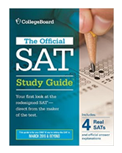 Official SAT Study Guide (2016 Edition) (Official Study Guide for the New Sat) — by The College Board
Official SAT Study Guide (2016 Edition) (Official Study Guide for the New Sat) — by The College Board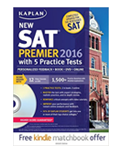 Kaplan New SAT Premier 2016 with 5 Practice Tests: Personalized Feedback + Book + Online + DVD + Mobile — by Kaplan
Kaplan New SAT Premier 2016 with 5 Practice Tests: Personalized Feedback + Book + Online + DVD + Mobile — by Kaplan Cracking the New SAT Premium Edition with 6 Practice Tests, 2016: Created for the Redesigned 2016 Exam — by Princeton Review
Cracking the New SAT Premium Edition with 6 Practice Tests, 2016: Created for the Redesigned 2016 Exam — by Princeton Review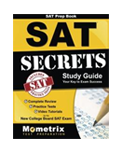 SAT Prep Book: SAT Secrets Study Guide: Complete Review, Practice Tests, Video Tutorials for the New College Board SAT Exam — by SAT Exam Secrets Test Prep Team
SAT Prep Book: SAT Secrets Study Guide: Complete Review, Practice Tests, Video Tutorials for the New College Board SAT Exam — by SAT Exam Secrets Test Prep Team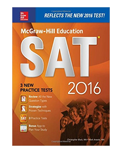 McGraw-Hill Education SAT 2016 Edition (Mcgraw Hill’s Sat) — by Christopher Black
McGraw-Hill Education SAT 2016 Edition (Mcgraw Hill’s Sat) — by Christopher Black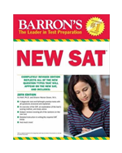 Barron’s NEW SAT with CD-ROM, 28th Edition — by Green, Wolf, and Stewart
Barron’s NEW SAT with CD-ROM, 28th Edition — by Green, Wolf, and Stewart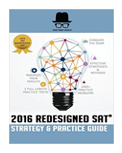 Test Prep Genius 2016 Redesigned SAT Strategy & Practice Guide — by TPGenius Development Team
Test Prep Genius 2016 Redesigned SAT Strategy & Practice Guide — by TPGenius Development Team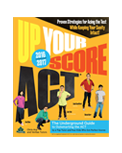 Up Your Score: SAT: The Underground Guide, 2016-2017 Edition (Up Your Score: The Underground Guide to the SAT) — by Berger, Colton, Mistry, et al.
Up Your Score: SAT: The Underground Guide, 2016-2017 Edition (Up Your Score: The Underground Guide to the SAT) — by Berger, Colton, Mistry, et al.
Smartphone Apps:
 Daily Practice for the New SAT — by The College Board (free)
Daily Practice for the New SAT — by The College Board (free) College Passport – SAT Edition — by Edupath (free)
College Passport – SAT Edition — by Edupath (free) SAT Prep: Practice Tests and Flashcards — by Varsity Tutors (free)
SAT Prep: Practice Tests and Flashcards — by Varsity Tutors (free) IntelliVocab for SAT — by Faqden Labs (free)
IntelliVocab for SAT — by Faqden Labs (free) SAT Up – Current and New SAT Exam Prep — by ScoreBeyond (free with in-app purchases)
SAT Up – Current and New SAT Exam Prep — by ScoreBeyond (free with in-app purchases) SAT Prep Kit: Math Practice Questions by — Pixerian (free with in-app purchases)
SAT Prep Kit: Math Practice Questions by — Pixerian (free with in-app purchases) SAT Math Testbank — by Testbank ($4.99)
SAT Math Testbank — by Testbank ($4.99) SAT Vocab — by Brainscape ($9.99) A bit more expensive than the other apps but it was recently ranked as the #1 SAT app.
SAT Vocab — by Brainscape ($9.99) A bit more expensive than the other apps but it was recently ranked as the #1 SAT app.
Videos:
- Big Changes to the SAT 2016! — (Top Test Prep)
- The New SAT – FULL TEST – Walkthrough — (Radical Prep)
- 5 Clever SAT Preparation Videos to Share with Your Tutoring Students — (Socrato!)
- The Redesigned SAT — (The Princeton Review)
- Free SAT Video Tips — (Veritas Prep)
- Writing: Argument — How-to example | New SAT — (Khan Academy)
- 4 SAT Critical Reading Strategies to Raise Your SAT Score — (SAT Prep Central)
- SAT Critical Reading — (WatchKnowLearn) A series of 3 videos about critical reading.
- SAT Test Prep — (Flex College Prep) Extensive test prep videos in different subject areas available to buy.
Test-Taking Strategies
The test will be hard enough, so work smart while taking it by using these tips for success:
General Strategies:
- Top Ten SAT Test Tips (About Education)
- Overall Test Tactics (Test Prep Resource Center)
- Top 3 SAT Tips (The Princeton Review)
- Top 10 time management tips for the SAT (Unigo)
Critical Reading:
- 5 Key SAT Critical Reading Strategies to Boost your SAT Score (About Education)
- 10 Must-Know SAT Reading Tips (Grockit)
- The Most Important SAT Critical Reading Tip (SAT Success Secrets)
- SAT Critical Reading Passages (Loudoun County Public Schools) A downloadable MS Word document with links to numerous resources.
Writing:
- How to Improve Your SAT Writing Score: 8 Key Strategies (PrepScholar)
- 5 Tips for Writing a Great SAT Essay (The Princeton Review)
- How To Write The New (Redesigned) SAT Essay (Robert Kohen)
Math:
- 6 Important SAT Math Strategies (Advanced Math Tutoring)
- SAT Math Tip: Four Strategies to simplify Your Problem (Chegg)
- How To Write The New (Redesigned) SAT Essay (Robert Kohen)
What If You Have a Low Score?
Two to three weeks after you take the SAT, your score will be available online. The waiting period between the test and your results can be quite nerve wracking. If you do as well or better than you expected, you’re now on your way to the next phase of your college career. But what if you don’t do as well as you had thought?
Even though that can be disheartening, there’s no reason to despair. First of all, the SAT doesn’t define who you are as a student or a person. It’s a snapshot of how you did on one test at one time on one day. Plus, you can always register to retake the test. Then, it’s time to put together a plan increase your score the next time around:
- identify the areas you need to improve;
- seek out the widely available online and print resources designed to help your performance;
- sign up for a prep course (online or in person); and/or
- hire a coach/tutor for one-on-one instruction.
As the articles at the links below discuss, there are a variety of reasons people don’t do well—especially the first time around—on the SAT, ranging from test anxiety to the nature of the SAT itself:
Why Smart Students Struggle with the SAT (Veritas Prep) Lists five reasons ranging from overconfidence to lack of preparation to understand why students may initially do poorly on the SAT.
I Think I Got a Bad SAT Score. Now What? (About Education) A collection of articles offering strategies to help students regroup after a (possibly misperceived) low score.
Pencils down: More U.S. colleges drop standardized tests (Reuters) Discusses a 2014 study of test-optional admissions involving 123,000 students at 33 schools which found no major difference in college grade point averages or graduation rates for students who submitted test scores vs. those who did not. In fact, the study’s lead investigator determined high school grade point average was a better indicator of college success than standardized test scores.
10 Myths about the SAT (FairTest) Debunks some common misperceptions about what the SAT can and cannot indicate.
In the end, while the SAT is an important element to accessing your higher education opportunities and achieving your personal goals—no pressure, right?!?—some thoughtful planning and diligent work ahead of time will help you maximize the benefits you receive from earning the best score possible.

